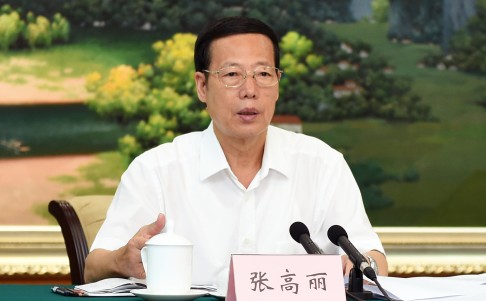
Great economic leap forward: China prepares for shift to market- and consumer-based economy

The five-year plan is the survivor of China's economic evolution. It is a vestige of a bygone Soviet age that has endured as other features of the command system have withered and fallen away. Gone are the collective farms, gone are the industrial targets and gone, too, are the fixed market prices.
But the five-year plan lives on. It does so largely because it has relevance in what is still a heavily centralised system, defining the Communist Party's strategy for what has become the world's second-biggest economy.
The party's decision-making Central Committee will meet from October 26 to 29 to approve a draft of the national economic and social development programme from 2016 to 2020. It will then be put to the National People's Congress for its rubber stamp in March before each region and industry comes up with its own programme that dovetails with the overall direction.
This time, as China's slowing gross domestic product expansion preoccupies policymakers and investors the world over, the 13th iteration of the plan is expected to confront two core issues: sustainable growth and an overhaul of the state sectors.
These issues are at the heart of China's monumental task to wean itself off exports and state-led investment growth, and prosper on domestic consumption, productivity and innovation.
Sustainable growth
The last three decades have been driven by cutthroat expansion and there is general consensus among observers that this growth-at-all-costs approach cannot go on. The economic miracle of double-digit growth exacted a huge toll on the environment and widened the gap between the rich and the poor.
And yet China must grow enough to avoid the middle-income trap, the stagnation that follows the failure of a fast-growing emerging economy to make the leap from low-cost, export-led manufacturing to domestic consumption and services.
Finance Minister Lou Jiwei caused a stir in April when he said there was a 50-50 chance this would happen to China in the next five to 10 years.
The priority for the next few years should be to make sure this does not happen, says Zhuang Jian , senior economics officer at the Asian Development Bank's PRC Resident Mission.
China needs to make the leap to a high-income economy to ensure most people can share the benefits of social and economic development, Zhuang says.
There are already signs that this could be a focus of the plan. When President Xi Jinping met the party chiefs of seven eastern provinces in late May to discuss the plan's framework, supporting and transforming growth were among 10 key areas he identified as priorities.
Zhang Guobao, former deputy chief of the National Development and Reform Commission (NDRC) - China's top planning agency, and one-time head of the National Energy Administration, has said the government's growth target over the plan period would be an annual average of 6.8 per cent.
The NDRC has reportedly asked think tanks and policy advisers for their suggestions, with the respondents divided into those advocating 6.5 per cent and those recommending 7 per cent.
Either target, if met, would ensure the government could meet its aim of doubling GDP and per capita income by 2020 from 2010.
Peking University Professor and former World Bank chief economist Justin Lin is the most optimistic forecaster, tipping a 7to 8 per cent growth rate for another 20 years.
That is in line with the World Bank's 7 per cent outlook for 2016-2020. But the two diverge beyond that, with the bank foreseeing an average of 5.9 per cent for years between 2021 and 2025, and an average of 5 per cent a year for 2026-2030.
The International Monetary Fund forecasts that growth will be about 6.8 per cent this year, slowing to 6.3 per cent in 2016 and 6 per cent in 2017.
The Chinese Academy of Social Sciences, the central government's top think tank, expects growth to fall to 6-6.5 per cent between 2016 and 2020 from an estimated 7.6 per cent over the previous five years.
The Economic Information Daily, affiliated with Xinhua, quoted several economists as forecasting the government might set a 6.5 per cent annual growth target for the 13th plan.
Specific numbers aside, what all seem to agree on is that growth is slowing and the only way to keep it ticking over is to increase household income so that more people can spend.
"The previous growth of GDP accumulated a lot of physical capital," says Lei Mao, a professor of finance at Warwick Business School. "But the standard of living for the average Chinese household is still well below that in developed countries - which is the main reason for the lack of domestic demand."
The second big task is to streamline state-owned enterprises (SOEs). China has already gone on the record saying it will let the market play a "decisive" role in the national economy.
SOE reform
State businesses still dominate large areas, weighing on growth. They are seen as responsible for most of China's economic woes, from overcapacity and deflation, to the asset bubble and mounting local government debt.
Economists say state monopolies' control of strategic markets is an obstacle to sustainable growth that should be scrapped to give the private sector a greater role.
China has in the past few months issued principles for SOE reform, but details are scarce. There is still no indication of how they will be merged, how government intervention will be reduced in day-to-day operations, or how these details will be incorporated into the five-year plan.
Linda Lim, professor of strategy at the Ross School of Business at the University of Michigan, says the solutions will have to vary from industry to industry and company to company.
"This is something that is difficult to generalise about … But the goal should be to make SOEs more efficient and more complementary rather than competitive with private enterprise, as well as limiting their claims on resources," Lim says.
One top priority of the 13th five-year plan will be to rebalance the economy away from SOEs to private enterprises, she says.
The government knows the most dynamic, self-sustaining parts of the economy are in the private entrepreneurial sector.
What the government can do here to encourage and enable private entrepreneurship … is to ensure a favourable institutional environment
"What the government can do here to encourage and enable private entrepreneurship … is to ensure a favourable institutional environment," she says.
"This includes secure property rights, such as intellectual property rights, and open competition, so that 'the best' businesses win and can attract talent and capital as well as customers," Lim says.
Other agendas
There is a raft of other issues that the plan is likely to address, but the most prominent of these is environmental protection.
Environment Minister Chen Jining has promised the plan will include "more forceful" energy company obligation measures to improve energy efficiency and cut carbon emissions.
Analysts believe there will be a total cap on carbon emissions - a first for China and a welcome step in the fight against climate change.
If so, it will build on a promise in November that the country's total emissions will peak by 2030 and that China will draw 20 per cent of its total energy consumption from non-fossil fuels by 2025.
Observers will also be watching to see if China will further relax its one-child policy as its population ages.

